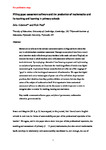Filling gaps: assessment software and the production of mathematics and its teaching and learning in primary schools
| dc.contributor.author | Alderton, J | |
| dc.contributor.author | Pratt, Nicholas | |
| dc.date.accessioned | 2021-04-20T13:05:38Z | |
| dc.date.issued | 2021-06-04 | |
| dc.identifier.issn | 1750-8487 | |
| dc.identifier.issn | 1750-8495 | |
| dc.identifier.uri | http://hdl.handle.net/10026.1/17055 | |
| dc.description.abstract |
Recent policy reforms to the national assessment system in England have altered the way in which teachers undertake assessment. Through an analysis of data from a small-scale interview study with eleven primary teachers in the south and east of England, we examine the ways in which teachers work with assessment software to monitor and track attainment. By employing a theoretical lens focusing on power and implementing an analytics of government, we illuminate the visualizing effects of whole class digital assessment grids. A prominent feature across the data set is the use of the language of ‘gaps’ in relation to the teaching and assessment of mathematics. We argue that digital assessment tools act as technologies of power and of the self which shape teachers’ practices, their identities, how they position children as learners, but also shape the nature of the subject of mathematics itself. It is important to better understand assessment software in education and the discourses in which it operates in order to recognise what is at stake for teaching, learning and curriculum. | |
| dc.format.extent | 501-515 | |
| dc.language | en | |
| dc.language.iso | en | |
| dc.publisher | Taylor & Francis (Routledge) | |
| dc.subject | analytics of government | |
| dc.subject | assessment software | |
| dc.subject | gaps | |
| dc.subject | governmentality | |
| dc.subject | mathematics education | |
| dc.title | Filling gaps: assessment software and the production of mathematics and its teaching and learning in primary schools | |
| dc.type | journal-article | |
| dc.type | Journal Article | |
| plymouth.author-url | https://www.webofscience.com/api/gateway?GWVersion=2&SrcApp=PARTNER_APP&SrcAuth=LinksAMR&KeyUT=WOS:000657961600001&DestLinkType=FullRecord&DestApp=ALL_WOS&UsrCustomerID=11bb513d99f797142bcfeffcc58ea008 | |
| plymouth.issue | 4 | |
| plymouth.volume | 63 | |
| plymouth.publication-status | Published | |
| plymouth.journal | Critical Studies in Education | |
| dc.identifier.doi | 10.1080/17508487.2021.1917435 | |
| plymouth.organisational-group | /Plymouth | |
| plymouth.organisational-group | /Plymouth/Faculty of Arts, Humanities and Business | |
| plymouth.organisational-group | /Plymouth/REF 2021 Researchers by UoA | |
| plymouth.organisational-group | /Plymouth/REF 2021 Researchers by UoA/UoA23 Education | |
| plymouth.organisational-group | /Plymouth/Research Groups | |
| plymouth.organisational-group | /Plymouth/Research Groups/Institute of Health and Community | |
| plymouth.organisational-group | /Plymouth/Users by role | |
| plymouth.organisational-group | /Plymouth/Users by role/Academics | |
| dcterms.dateAccepted | 2021-04-12 | |
| dc.rights.embargodate | 2022-12-4 | |
| dc.identifier.eissn | 1750-8495 | |
| dc.rights.embargoperiod | Not known | |
| rioxxterms.versionofrecord | 10.1080/17508487.2021.1917435 | |
| rioxxterms.licenseref.uri | http://www.rioxx.net/licenses/all-rights-reserved | |
| rioxxterms.licenseref.startdate | 2021-06-04 | |
| rioxxterms.type | Journal Article/Review |


